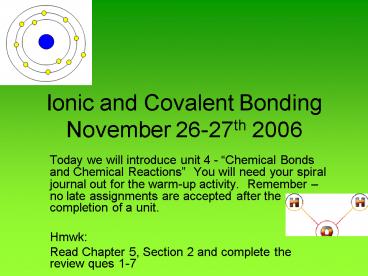Ionic and Covalent Bonding November 2627th 2006 - PowerPoint PPT Presentation
1 / 26
Title:
Ionic and Covalent Bonding November 2627th 2006
Description:
That's because the ions are then free to move. Covalent Bonds ... best imagined as a room full of puppies who have plenty of bones to go around ... – PowerPoint PPT presentation
Number of Views:53
Avg rating:3.0/5.0
Title: Ionic and Covalent Bonding November 2627th 2006
1
Ionic and Covalent BondingNovember 26-27th 2006
- Today we will introduce unit 4 - Chemical Bonds
and Chemical Reactions You will need your
spiral journal out for the warm-up activity.
Remember no late assignments are accepted after
the completion of a unit. - Hmwk
- Read Chapter 5, Section 2 and complete the review
ques 1-7
2
Agenda
- Warm-Up What is a chemical bond?
- Notes Types of Bonds
- Activity Modeling Chemical Bonds
- Discussion Lab Wrap-Up
3
Warm-Up
- What is a chemical bond?
4
How are chemical bonds related to the following
pictures?
5
(No Transcript)
6
(No Transcript)
7
Atoms form bonds in order to gain a stable
electron configuration
- Atoms bond when their valence electrons interact.
- Atoms are more stable when their valence shell is
full. - A stable atom is similar to a noble gas group
18.
8
- Hydrogen atoms are more stable when bonded to
another atom. - Once bonded, the hydrogen atom resembles what
noble gas? - Why is this carbon atom more stable?
- What noble gas does it resemble?
9
- When two hydrogen atoms are very close together,
their electron clouds overlap, and a bond forms.
- The two electrons of the hydrogen molecule are in
a shared electron cloud.
10
Bonds can bend or stretch without breaking
- All bonds behave like flexible springs.
- Bonds are not rigid but they still hold atoms
together tightly.
11
Ionic Bonds
- Definition a bond formed by the attraction
between oppositely charged ions. Electrons
transferred - Bonding partners
- metals( ions) and nonmetals (- ions)
- Characteristics Tend to form more brittle
crystals, high melting point, good conductors of
electricity
12
Ionic Bond
13
One Big Greedy Thief Dog!
If the bone represents the electron that is up
for grabs, then when the big dog gains an
electron he becomes negatively charged and the
little dog who lost the electron becomes
positively charged. The two ions (that's where
the name ionic comes from) are attracted very
strongly to each other as a result of the
opposite charges.
14
Ionic compounds are in the form of networks with
a fixed ratio of ions
- Example NaCl has a 11 ratio
15
When melted or dissolved in water, ionic
compounds conduct electricity
- Electric current involves moving charges.
- If you dissolve an ionic compound in water or
melt it, it can conduct electricity. Thats
because the ions are then free to move.
16
(No Transcript)
17
Covalent Bonds
Definition A bond formed when atoms share one or
more pairs of electrons Bonding partners Takes
place between two nonmetals Characteristics
lower melting points, poor conductors of
electricity
18
Dogs of equal strength!
Since the dogs (atoms) are identical, then the
dogs share the pairs of available bones evenly.
Since one dog does not have more of the bone than
the other dog, the charge is evenly distributed
among both dogs. The molecule is not "polar"
meaning one side does not have more charge than
the other.
19
Polar vs. Nonpolar
- Polar covalent bonds atoms share electrons
equally H2O - Nonpolar covalent bonds atoms dont share their
electrons equally N2
20
Unevenly match but willing to share.
The bigger dog has more strength to possess a
larger portion of the bones. Sharing still takes
place but is an uneven sharing. In the case of
the atoms, the electrons spend more time on the
end of the molecule near the atom with the
greater electronegativity (desire for the
electron) making it seem more negative and the
other end of the molecule seem more positive.
21
Electronegativity
- the tendency of an atom to attract bonding
electrons to itself when it bonds with another
element.
22
Metallic Bonds
- Definition
- a bond formed by the attraction between
positively charged metal ions and the electrons
around them - Electrons are free to move from atom to atom.
- Characteristics conduct electricity, flexible
- Metals are flexible because the atoms can slide
past each other without their bonds breaking. - Allow metals to conduct electricity - they can
stretch or be hammered flat without breaking.
23
Mellow dogs with lots of bones to go around.
These bonds are best imagined as a room full of
puppies who have plenty of bones to go around and
are not possessive of any one particular bone.
This allows the electrons to move through the
substance with little restriction. The model is
often described as the "kernels of atoms in a sea
of electrons."
24
(No Transcript)
25
(No Transcript)
26
Molecular Model Lab
- Construct molecules out of colored marshmallows
and toothpicks. Each color represents the
following elements - Yellow Carbon White Hydrogen
- Pink Oxygen Orange Nitrogen
- Green Chlorine
- Use your electronegativity chart to determine
whether a bond is ionic, nonpolar covalent or
polar covalent.































